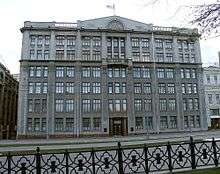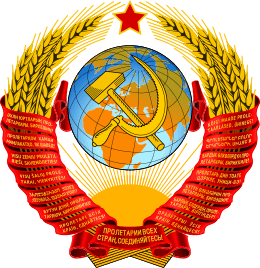Secretariat of the Communist Party of the Soviet Union
The Secretariat of the Central Committee of the Communist Party of the Soviet Union (CPSU), often referred to as the Secretariat of the CPSU Central Committee, had responsibility for the central administration of the party as opposed to drafting government policy (which was usually handled by the Politburo).
 Emblem of the CPSU | |
| Information | |
|---|---|
| General Secretary | Elena Stasova (first) Joseph Stalin Mikhail Gorbachev (last) |
| Elected by | Central Committee |
| Parent | Central Committee |
| Seats | Varied |
| Meeting place | |
 | |
| Staraya Square, Moscow, Russian SFSR[1] | |
Overview
The members of the Secretariat were elected by the Communist Party's Central Committee, although in all but the first years of its existence the elections were a formality since decisions were made by the senior leadership before the voting. The General Secretary of the CPSU, who was also a Politburo member, was the leader of the Secretariat and of the Party. Dual membership in the Secretariat and the Politburo was in practice reserved for two or three very senior members of the Soviet leadership, and in the post- Stalin era (after March 1953) was a stepping-stone to ultimate power. The last five Soviet leaders (Nikita Khrushchev, Leonid Brezhnev, Yuri Andropov, Konstantin Chernenko and Mikhail Gorbachev) were all senior Secretaries before becoming First or General Secretaries. Additionally, Georgy Malenkov was briefly reckoned as the leader of the Party for a week after Stalin's death by virtue of being the top member of the Secretariat.
The Central Committee established the Secretariat on 6 August 1917; it initially comprised Felix Dzerzhinsky, Matvei Muranov and Yakov Sverdlov as full members and Adolph Joffe and Elena Stasova as candidate members (or alternates). Following the October Revolution of November 1917, Sverdlov and Stasova in effect handled the work of the Secretariat as the other members of the body assumed other duties. At the time, the Secretariat was[2] responsible for technical issues such as coordination of the activities of regional Party organizations and handling routine administrative affairs of the Party. Its staff increased from just 30 in 1919 to 600 in 1921 and to 767 by 1925.
By 1922 the body had transformed from a technical committee to become one of the most important components of the Party, and from that point on it was responsible for day-to-day operations of the Communist Party. Also in 1922, the position of General Secretary was created, the General Secretary became the head of the Secretariat and, in the years following Lenin's death in 1924, became the most important figure in the Party and in the Soviet Union.
See also
- Politburo of the Communist Party of the Soviet Union
- Organization of the Communist Party of the USSR
References
- Bazhanov, Boris (1992). Борис Бажанов. Воспоминания бывшего секретаря Сталина. St. Petersburg: Всемирное слово. Retrieved 1 March 2018.
- Alan Bullock, Hitler and Stalin: Parallel Lives, p. 121-124.
